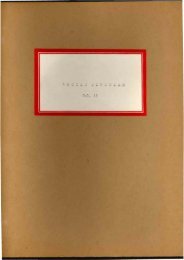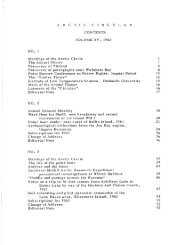Volume 4, 1951 - The Arctic Circle - Home
Volume 4, 1951 - The Arctic Circle - Home
Volume 4, 1951 - The Arctic Circle - Home
Create successful ePaper yourself
Turn your PDF publications into a flip-book with our unique Google optimized e-Paper software.
111 it be possible to determine what number of animaIs may<br />
e killed annually by hunters, without endangering the main<br />
tock.<br />
Barren ground caribou were once plentiful in Ungava<br />
d Labrador but during the last fifty years they have almost<br />
ompletely vanished and only in recent years have there been<br />
eports of slight increases in the Fort Chimo area (Wright,<br />
944; ~anning, 1948); in Baffin Island caribou have been<br />
creasing during the last few decades at such an alarming<br />
te that total protection has lately been considered<br />
cessary. Labrador-Ungava and Baffin Island physiographically<br />
e very different from the vast continental area west of<br />
dson Bay but in many respects are comparable with the iceee<br />
parts of Greenland.<br />
Several causes have been advanced to explain the rapid<br />
sappearance of the barren land caribou in Labrador-Ungava<br />
t thus far no very satisfactory explanation has been given.<br />
Baffin Island, however, it is thought that excessive<br />
nting is the primary cause of depletion (Wright, 1944).<br />
actically no statistical information is available for either<br />
ea and it is not possible, therefore, even to estimate past<br />
present populations of the numbers killed by hunting. ln<br />
e~nland, on the other hand, caribou have been rather closely<br />
served for more than two hundred years by Danish scientists<br />
d administrators, and it may be of interest to note briefly<br />
at has happened there. ln comparing the two areas it should<br />
noted that in Greenland the caribou is more vulnerable to<br />
ting because the ice-free parts of Greenland are deeply<br />
dented by fjords which in many parts extend to the very<br />
e of the great inland ice which covers aIl the interior<br />
that island. <strong>The</strong>se fjords not only make the areas inbited<br />
by caribou accessible to Eskimo hunters summer and<br />
nter, but they also impede north and south migration of the<br />
ibou. Furthermore, there are places along the Greenland<br />
sts where huge glaciers, in some cases more than 50 miles<br />
width, form impassable barriers to coast-wise migration.<br />
<strong>The</strong> Greenland caribou, on the other hand, does not<br />
ffer from the predation of warble or nostril flies because<br />
ose pests apparently never reached Greenland. On the west<br />
st, too, there are no wolves. Another factor which unbtedly<br />
has been of inestimable conservational value is<br />
t even to this day aIl hunting in Greenland is done with<br />
le-shot rifles. No loaded shells are sold to Greenlanders<br />
can buy only black powder for reloading. V/hile the use<br />
.single-shot, black powder rifles and shotguns may at first<br />
earance seem anachronistic, the practice nevertheless is












